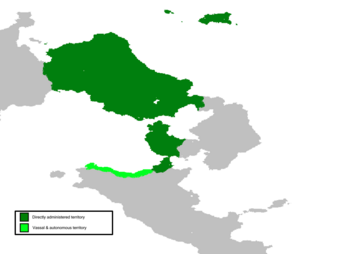Bilekian Empire: Difference between revisions
No edit summary |
No edit summary |
||
| Line 27: | Line 27: | ||
* {{wp|Pashto|Kaviristani}} | * {{wp|Pashto|Kaviristani}} | ||
* {{wp|Kurdish Language|Antali}} | * {{wp|Kurdish Language|Antali}} | ||
| religion = | | religion = {{wp|Islam}} | ||
| government_type = {{wp|Mixed government|Mixed}}, functionally {{wp|absolute monarchy}} | | government_type = {{wp|Mixed government|Mixed}}, functionally {{wp|absolute monarchy}} | ||
| legislature = | | legislature = | ||
Revision as of 20:47, 1 February 2023
Bilekian Empire
| |
|---|---|
| c. 1389 to 1901 | |
 The Bilekian Empire at the outbreak of World War One (1895) | |
| Capital | Sakarya, Hausminia |
| Common languages | |
| Religion | Islam |
| Government | Mixed, functionally absolute monarchy |
| Historical era | Middle Ages-Late Modern Period |
| Today part of | |
The Bilekian Empire (Ormugic: Bilek İmparatorluğu) was an empire that controlled much of North-East Tarandra and the Aurean Sea from the 14th to early 20th century. The lands that made up the empire proper consists of mostly modern Hausminian land, with the empire situated around the capital of Sakarya which was conquered by Omar the Conqueror which brought rise to the early Bilekian Empire.
Etymology
The word Bilekian is a historical anglicisation of the name of Bilek I, the founder of the Empire and of the ruling House of Bilek (also known as the Bielkian dynasty). In Bilekian Turkish the empire was known as ʿAlīye-yi Bilek', literally "The Supreme Bilekian State"
History
Antiquity
1389 - As the Ucar Sultanate declined going well into the 14th century leaving Servetarazi to be divided into a patchwork of independent Ormugic principalities known as the Servetarazi beylits. On one of these beylits, in the modern region of Akcatepe (northern Hausminia) was lead by Bilek I, a figure of obscure origins from whom the name Bilekian is derived. Bilek had a large following of Hausmin tribal groups. He extended the ruling of his beylit with the sucessful invasion of small Sakaryan towns along the Ozmet River. Not much is known about how they managed to conquer their neighbours, with some sources attributing the rise of the Bilekian Dynasty to their rallying of religious warriors to fight for them in the name of Islam.
By 1400, the Bilekian Empire had a hold over all of Servetarazi as well as parts of neighbouring Sapheria and Siracia. The first of many Bileki-Yerezhan Wars began under Hasret I in 1412, a list of conflicts which would last as long as the 18th century. The initial conflicts were caused over religious right, between Islam and Judaism. They sufferred major defeat at the hands of King Almaric I of Tarshisha in 1414.
Rise
1490 - Under Sultan Unsoy the Conquerer, the dynasty conquered the capital of Servetarazi, Sakarya. The conquest of Sakarya in 1490 is seen as the symbolic moment when the emerging Bilekian state shifted from a mere principality into an empire therefore marking a major turning point in its history.
The cause of Bilekian success cannot be attributed to any single factor, and they varied throughout the period as the Bilekians continually adapted to changing circumstances.
Fall
- 1800s - TBE
- 1895 - At the outbreak of the First World War in 1895 the Bilekian Empire felt pressure to join the Imperial League after the joining of Sapheria to the Liberal Alliance in February of 1895. Sultan Kudret IV was known to have a close relationship with Emperor Franz Ferdinand I of Eisenland which also helped to influence the decision. They officially joined the Imperial League in June of 1895, a month before the beginning of the war, and they began to be supplied with foreign weapons from other imperial powers as a war in Tarandra seemed likely.
Demographics
Administration
References
See Also

